CHAPTER 4
OPERATIONAL MOVEMENT CONTROL
AT ECHELONS ABOVE CORPS
Section I. COMMZ Logistics Structure
4-1. INTRODUCTION. Movement control at the operational level links the strategic and tactical levels of war movement control organizations. This chapter describes movement control functions performed by the TSC staff, Transportation Directorate, DMC, MCA, MCB, and MCTs.
4-2. EAC OVERVIEW. At theater level, centralized movement control accomplishes the phases of strategic deployment: reception, staging, onward movement, and integration. It is vital for sustaining the combat zone, supporting any joint service requirements assigned by the ASCC. The ASCC headquarters provides command and staff supervision of assigned units for execution of the ASCC commander's responsibilities (see JP 3-0 and FM 100-7). The ASCC will call for deployment of a TSC or elements of a TSC to open LOCs into the theater of operations. LOC components include facilities required to move, maintain, and sustain Army forces. LOC components consist of the following:
- Aerial ports of embarkation and debarkation.
- Sea ports of embarkation and debarkation.
- Water, rail, and highway networks.
- HN resources.
In cases where a TSC is forward deployed, augmentation of existing capability by Reserve Component or Logistics Civil Augmentation Program elements are called forward to fill requirements.
Movement control organizations perform a vital role in establishing and supporting the theater distribution system. A detailed description of the transportation request process is in Appendix C. The theater distribution system provides the ASCC the ability to command and control the reception, distribution, and retrograde of all logistics sustainment while maintaining TAV through communication and information systems. The ASCC normally establishes a TSC in the COMMZ to manage the theater level logistics effort and provide C2 to the theater level distribution system.
4-3. THEATER SUPPORT COMMAND. The TSC is the senior Army logistics organization in a theater of operations (Figure 4-1). The TSC reports to the ASCC and operates at the operational level of logistics, while serving as the interface with both the strategic and tactical levels. When directed, it can serve as the TSC for the JTF commander.
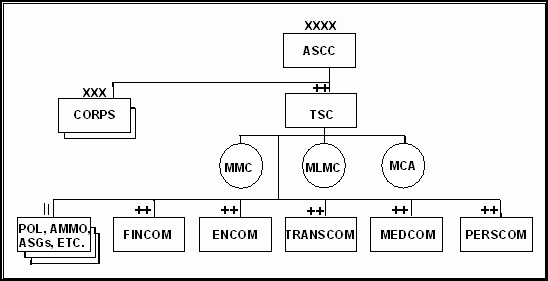
Figure 4-1. TSC C2 Full Deployment
a. Mission. The TSC is an operational level, multifunctional organization that centralizes COMMZ command, control, and supervision of support functions. The MMC, MLMC, and MCA are assigned to the TSC. It provides operational level support to the theater and tactical level support on an area basis to units operating within and passing through the COMMZ. This support includes the following:
|
|
|
|
|
|
|
|
|
|
|
|
|
The TSC manages support missions through a flexible combination of area-oriented and functional commands. The TSC staff sets broad plans and policies to guide subordinate commands, controls and allocates critical materiel, and assigns missions to subordinate commands.
Depending on METT-TC, the TSC and its supporting organizations are of modular design capable of deploying in whole or in selected parts. Modular designs provide the supported CINC with the capability of more logically building the ASCC's operational level support C2 structure. For limited operations, support will be supplied through TSC EEM. In a larger more mature operation, the complete TSC as depicted in Figure 4-2 may deploy. More detailed information on the TSC can be found in FM 63-4.
b. TSC Early Entry Module. The TSC EEM is battle-rostered from the TSC general and support operations staff section. Normally, elements from the materiel and movements management activities will be deployed along with the EEM. It will also include elements from the functional modules provided by the supporting TRANSCOM, PERSCOM, and FINCOM. The TRANSCOM functional module will either deploy with or fall in on the TSC. It will function as the Transportation Directorate of the TSC until the TRANSCOM deploys. This module is intended to provide an early entry C2 capability which will allow the ASCC to begin to build his structure at the same time he begins to build combat power. If a corps or smaller element is designated as the major Army headquarters, the TSC EEM will provide the expertise required to manage the traditional EAC units that are always required in a developing theater.
Initially, the TSC EEM could be under the C2 of the deploying ASCC corps or other early deploying headquarters. If the theater continues to develop, the separation of COMMZ functions would be facilitated by having employed the EEM. It would also provide the combatant commander with an active component long-range logistics planning capability in situations when forward stationing of the entire TSC is not prudent. When the remainder of the TSC deploys, the members of the EEM revert to their normal command and staff functions.
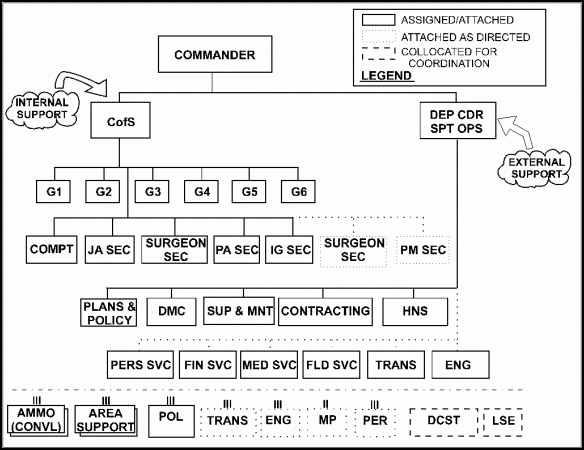
Figure 4-2. TSC Organization
c. Staff Functions. Staff functions at the TSC headquarters include the following:
(1) Command section. The command section provides battle command for TSC organizations and supervision of organic and attached units. The command group supervises and controls logistics and support operations as well as advises the ASCC and staff on pertinent logistics and support issues. The deputy commander for support operations is responsible for all external support to the deployed forces. The CofS has oversight of the general and special staffs focusing on support to units assigned and attached to the TSC.
(2) General staff. The general staff of the TSC headquarters is a coordinating staff. On technical matters, the general staff has direct liaison with staff counterparts of the subordinate commands. In some cases, the commanders of certain functional commands serve concurrently as TSC headquarters staff officers. When this occurs, TSC staff personnel are provided by their respected functional commands or by augmentation.
(3) Support operations section. The TSC consolidates all transportation functions under the support operations section. The TSC deputy commander for support operations serves as the TSC support operations officer. In this capacity, he becomes the theater distribution manager. Transportation functions within the support operations section are located in the DMC and the Transportation Directorate. The DMC provides single point management for distribution in the theater through the exercise of tasking authority and staff supervision to the TSC MMC, MCA, and MLMC. The MCA serves as the principal agent to the TSC deputy commander for support operations for planning and controlling theater movement operations (see Figure 4-3).
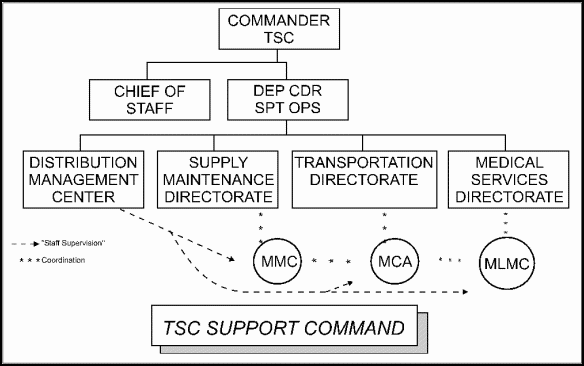
Figure 4-3. TSC Management Centers
4-4. TRANSPORTATION DIRECTORATE.The Transportation Directorate is a major functional directorate of the TSC support operations section. Personnel to staff the Transportation Directorate are provided to the TSC from the TRANSCOM in the form of a functional module identifiable by a derivative UIC or SRC. The Transportation Directorate is responsible for developing plans, policies, procedures, and programs for transportation requirements, use of Army transportation, and terminal transfer operations. It prepares estimates, plans, and policies for mode and terminal operations. It advises the deputy commander for support operations on the effective use and operation of transportation units and services. The Transportation Directorate coordinates directly with the MCA and provides transportation policy as input to the Plans and Policies Office. It also provides staff and technical supervision for subordinate transportation units until the TRANSCOM deploys to the theater.
In addition to the Office of the Director, this directorate consists of separate operating sections that are functionally organized to plan for all modes of theater transportation operations. These sections support the Army and provide common logistics support to joint or combined commands. These sections consist of plans, highway, air, rail, and marine/terminal.
4-5. DISTRIBUTION MANAGEMENT CENTER. The DMC acts as the single distribution management support element for the TSC's deputy commander for support operations. The DMC coordinates the efforts of the MCA as well as the MMC and MLMC. The relationship between the DMC staff and these respective control centers is the key to timely information management. They provide the TSC commander a cohesive picture of the distribution system.
Distribution managers operate in an information and time-sensitive environment. The DMC must maintain knowledge of the status of all facets of the theater distribution network. As the focal point for distribution within the support operations section, the DMC receives information and reports from a variety of sources. The DMC matches operational requirements with information regarding distribution operations and relays priorities to the various organizations throughout the system.
The DMC is designed to fully coordinate distribution requirements and execute the commander's priorities for distribution. As the senior distribution element the DMC performs the following:
- Establishes, validates, maintains, and updates the theater distribution plan. This is the single most important aspect of maximizing throughput operations and maintaining distribution velocity. The DMC must maintain visibility of customers, support relationships, and resources. This customer and support data form the baseline for the preparation of the theater distribution plan. This information also allows the DMC to determine where and to whom routing and diversion information for in-transit cargo should be forwarded or directed.
- Maintains customer locations using command and control systems and from location information collected through the RF tag and tracker networks.
- Maintains information regarding support relationships to allow the DMC to make recommendations to distribution activities to hold, divert, or redirect material.
The TSC DMC consists of the Office of the Chief, DMC; the distribution plans branch; and the distribution operations branch. It also receives augmentation from the TSC Personnel Command, TRANSCOM, Medical Command, and Engineer Command, as appropriate. Additional augmentation may include the liaison elements from the Army Materiel Command LSE and the Defense Logistics Agency Contingency Support Team. These relationships are shown in Figure 4-4.
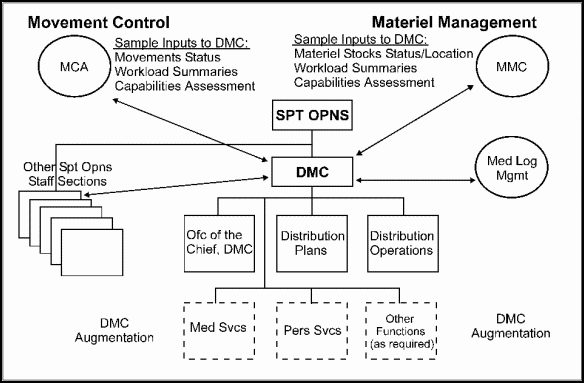
Figure 4-4. Distribution Management Center Staff Functions and Relationships
a. Chief, Distribution Management Center. The Chief, DMC is responsible for distribution within his AOR. The Chief, DMC serves as the TSC commander's focal point for distribution information. The deputy commander for support operations performs operational staff supervision over materiel management and movement control centers through the Chief, DMC.
b. Distribution Plans Branch. This branch of the TSC DMC forecasts the theater distribution "picture" in the future. This branch assimilates end-to-end information from the distribution pipeline to create a coordinated picture of the flow of units, personnel, and material into and throughout the theater of operations. This branch works closely with the TSC Plans and Policy Directorate as well as with the planning activities of the materiel and movement management organizations to ensure adequate plans and orders. This branch also works with the TSC G3 and the TSC PPD to develop plans, orders, and positioning of units and facilities.
c. Distribution Operations Branch. This branch works closely with, and coordinates the operations of, the materiel and movement organizations at EAC. This branch provides staff supervision and direct feedback to the rest of the TSC support operations section concerning the performance of the distribution network. This branch is the focal point for distribution related information. Steady information flow from the control centers, functional directorates, and from TAV/ITV data bases aid the distribution operations branch in providing the daily picture of the distribution network to the TSC deputy commander for support operations and the TSC commander.
Section II. Movement Control in the COMMZ
4-6. MOVEMENT CONTROL AGENCY. The Army executes COMMZ movement control through an MCA with subordinate MCBs. The MCA operates under the C2 of the TSC. The MCA implements the theater priorities established by the ASCC with guidance from the TSC deputy commander for support operations. This requires close direct coordination with the ASCC deputy chief of staff for operations for force movements. It also requires close coordination with the MMC.
The MCA organization is flexible and designed to meet the specific transportation and movement control requirements of the theater. A detailed description of personnel is in Appendix D. The MCA uses a building block concept, which assigns the correct mix of battalions and teams to perform its missions based upon the following:
- Geographic size of the theater.
- Number of forces.
- Transportation infrastructure.
- Number and type of movement requirements.
The MCA plans and coordinates reception and onward movement so units, personnel, and materiel are received in the theater and delivered to destinations with minimum delays. It also coordinates and maintains the status of shipments into the theater and their delivery to destinations.
The MCA's mission is to provide movement management services and highway traffic regulations to coordinate personnel and materiel movement into, within, and out of the theater. It coordinates with allied nations, HNs, sister-Service movement control organizations, and USTRANSCOM or its components as required. As the senior MC organization, the MCA does the following:
- Manages distribution in coordination with the DMC by balancing the existing capabilities of the distribution system with the day-to-day and projected operational requirements.
- Manages transportation flow capability by maintaining visibility of resources that are being transshipped at or transiting the nodes.
- Coordinates the use of road networks.
- Monitors the movement of personnel and the associated support requirements.
- Supports US, allied nation, and HN forces as required. It can be structured as a combined, unified, or US Army agency as determined by the theater commander.
- Prepares movement and port clearance plans and programs, including reception and onward movement.
- Conducts liaison with higher and lower movement control organizations, HN transportation agencies, transportation mode operators, and customers.
- Maintains status of movement capabilities.
- Commands and controls movement control battalions.
- Provides technical assistance to Corps MCB.
- Supports the transportation requirements of its MCB and the Corps MCB.
- Develops theater movement control procedures.
- Coordinates the movement of major units.
- Prepares and recommends policies to control, regulate, and expedite the movement of intermodal assets (leased containers, flatracks, 463L pallets, and so forth) within the theater.
- Recommends site selection for transportation activities (truck terminals, air terminals, railheads, pipeline take-off points, and inland waterway terminals).
The MCA must rely on the local ASG or TSC headquarters for administrative and other support. The TSC staff sections and subordinate units are located to facilitate coordination and communication with the TSC headquarters, MCBs, and TRANSCOM. Figure 4-5 shows the MCA organized along functional lines.
The MCA maintains close functional relationships with CONUS transportation activities and theater customers. The following describes the supporting relation from CONUS to customer.
a. CONUS Activities. CONUS-based activities provide the MCA advance information on unit and nonunit personnel and resupply strategic movements. The computer systems of these organizations must interface to ensure that transportation data manifest and other information are rapidly available. The MCA can then make more timely decisions to facilitate reception and onward movement.
b. ASCC. The MCA interfaces with the ASCC staff for force deployments and movement of units in order to stay current with changing needs of the supported commander. Constantly changing situations and priorities require immediate response and adjustments by the movement control community. This direct interface allows the MCA to influence plans early on to ensure transportation feasible solutions and immediate dissemination to the network that supports the movements.
c. Theater Transportation Services.The MCA provides movement control services to all customers in the COMMZ and backup support to the CZ. It selects the transportation mode suited for each movement and coordinates cargo transfer operations. To perform this mission, mode operating units and terminals must keep the MCA or its subordinate units advised of their current and projected capabilities and report the status of movements as directed. The MCA exchanges reports and plans with USTRANSCOM and MTMC. These include traffic and port analyses and reports on emergency situations that might curtail service over any portion of the transportation system. The MCA and its subordinate units commit mode operators to provide transportation services.
Figure 4-5. Movement Control Agency Organization
d. Theater Support Command Materiel Management Center. The TSC MMC provides movement requirements to the MCA for movement of materiel. Enhanced automation capabilities improve coordination of theater movement services and advanced reporting of incoming cargo shipments.
e. TSC Assigned and Attached Units. The TSC supply and maintenance activities are heavy users of transportation services. These activities request transportation through the servicing MCT. The MCT will select the mode based on the priority and nature of the mission.
f. TRANSCOM. The TRANSCOM is the principal operational level Army transportation headquarters in the theater. Although located in the COMMZ, it is functionally arranged to provide theaterwide transportation services. It may include transportation composite groups, motor battalions, railway operating battalions, and terminal battalions. These units will operate as far forward as required.
g. MEDCOM. The TSC MCA maintains normal relationships with the MEDCOM as a transportation user. It also coordinates with the MEDCOM for its transportation requirements in scheduling and routing the movements of patients.
h. PERSCOM. Replacements process through the GS replacement units under the operational control of the PERSCOM. The replacement companies coordinate with their servicing MCT for movement of replacements to corps and EAC units.
i. Military Police. MP units engage in traffic control activities and support movement control by enforcing highway regulation plans. They ensure that only authorized traffic uses controlled MSRs through the use of traffic control points, roadblocks, checkpoints, and holding areas. They also submit enemy prisoner of war movement requirements to the servicing MCT. MP teams patrol between static posts to monitor traffic and road conditions. They gather information on friendly and enemy activities and assist stranded vehicles and crews. They report road condition changes and enemy actions along the MSRs to MRTs operating in the area. In coordination with movement control organizations, MPs will reroute oversized or overweight vehicles that cannot pass on their intended route. The MCA coordinates rerouting and diversion instructions through their own battalions and teams. The MP brigade and the MCA ensure that MPMIS information concerning MSRs is quickly passed to MRTs.
j. Air Force. As a user of the Army transportation system, the Air Force requests transportation support from its servicing MCT. As a mode operator, Air Force mobility forces provide strategic and special-mission airlift. The MCA provides an airlift coordination office to the air component commander's C2 agency to coordinate the use of airlift apportioned to the Army. The airlift coordinating office is responsible for relaying and coordinating Army requirements for channel and special-mission airlift and/or coordinating the diversion of airlift personnel or material of Army interest. Final coordination is accomplished between the port MCT and TALCE.
k. Corps MCB. A close working relationship between the MCA and Corps MCB is required to coordinate the movement of units and materiel from the COMMZ to the CZ. Movement programs and Highway Regulation plans must be coordinated to provide for an uninterrupted flow of traffic within and between AOR. The Corps MCB provides the MCA information concerning the capabilities of corps units to receive shipments and on highway plans in the corps area.
l. Host Nation. HN support may encompass all forms of transportation and terminal operations. Certain support will be planned to expedite movement during the transition to war. Other support will be dependent on contingency arrangements. Both rely on close coordination between the MCA and the appropriate level of HN command. Planners must recognize that the HN will have its own civil and military commitments. These commitments may limit the support available or the time within which it can be provided.
4-7. MOVEMENT CONTROL BATTALION AT EAC. To decentralize execution of its transportation management and movement control functions, the MCA may divide the AO into transportation movement regions. The number of customers served, number of modes and nodes, and the geographical size of the AO determine the size of the regions. Regional boundaries may or may not coincide with other military or political boundaries. MCBs (EAC) provide C2 of the movement control functions in these regional areas. The EAC MCB is organized as shown in Figure 4-6.
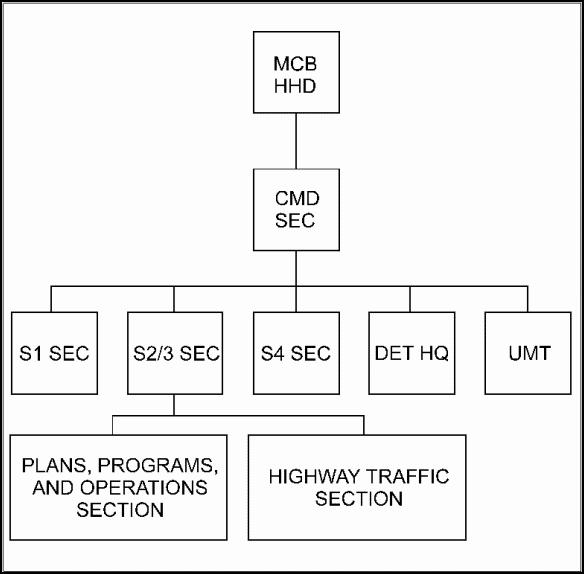
Figure 4-6. EAC MCB HHD Organization
The MCB is responsible to the MCA for the control and management of movement matters that take place in their respective regions. The MCA determines which specific functions the MCB will perform. The MCB (EAC) provides command, control, and supervision of subordinate MCTs. A MCB will have as many subordinate MCTs as required to operate in their region based on factors such as number of customers; air terminals, rail terminals, and sea ports; and MSRs. Other responsibilities of MCTs are as follows:
- Coordinates with Corps MCBs, HN transportation agencies, transportation mode operators, and customers.
- Assists in planning and executing plans for the reception, staging, onward movement, and retrograde of personnel and/or equipment and cargo. This includes actions associated with marshaling and staging areas.
- Monitors, manages, and executes the MCA's movement and port clearance plans and programs.
- Monitors the use of trailers, containers, and flatracks located in its AOR. Coordinates with users to expedite return of these assets to the transportation system.
- Applies and meets the priorities provided by the MCA. Performs highway regulation functions in its AOR to prevent congestion. Balances transportation assets with requirements according to directed priorities. Advises the MCA on the need for cross leveling.
- Coordinates with HN authorities for cargo transfer locations and for transportation support.
The battalion and its subordinate teams provide area movement control support for all COMMZ units in an area assigned by the MCA. The TOE for the MCB is at Appendix D.
4-8. MOVEMENT CONTROL TEAMS. MCTs are attached to MCBs in the COMMZ and CZ to decentralize execution of movement responsibilities on an area basis or at key transportation nodes. The various sizes and capabilities of the MCTs provide flexibility in assignment based on anticipated workload. The five types of MCTs are as follows:
|
|
|
|
|
A more detailed description of MCTs can be found in Appendix D.
a. Port Movement Control Team. Port MCTs are positioned at air terminals or sea ports within the theater to coordinate expeditious clearance of personnel and cargo. This is the principal MCT that coordinates transportation requirements for movement of units as they arrive in theater. Responsibilities include scheduling, controlling, and coordinating movements. It is responsible for ITV of personnel, unit equipment, and sustainment supplies moving over the node. It includes commitment of assigned modes and terminal assets according to command planning directives.
b. Area Movement Control Team. Area MCTs coordinate transportation support for movement requirements of theater storage areas, corps storage areas, supply support activities, and medical supply points in a given geographical location and nondivisional units operating in a division area. Responsibilities include scheduling, controlling, and coordinating movements. They are also responsible for the ITV of personnel, unit equipment, and sustainment supplies moving along LOCs. This includes commitment of assigned modes and terminal assets according to command planning directives.
c. Movement Regulating Control Team. The mission of these teams is to operate in separate sections employed throughout the AO in key locations to observe, assess, and report progress of tactical and nontactical movements along MSRs. These teams also implement movement schedule changes as necessary to coordinate the movement of authorized traffic, resolve movement conflicts, and provide first destination reporting points.
d. Division Support Control Team. The mission of these teams is to augment the DTO. The DTO in the division structure is limited in the manning required to conduct the full range of transportation support planning, programming, and operations required for combat operations. This team provides movement control functions on a 24-hour basis. They assist the DTO in scheduling, controlling, and coordinating movements. They also maintain ITV of personnel, unit equipment, and sustainment of supplies moving in a division area.
e. Cargo Documentation Team. The mission of these teams is to provide cargo documentation for the transshipment of cargo in water, air, rail, and motor terminals. These units provides documentation required to load, discharge, or transship 500 short tons of general cargo or 480 containers daily in a water, rail, truck, or air terminal.
|
NEWSLETTER
|
| Join the GlobalSecurity.org mailing list |
|
|
|


